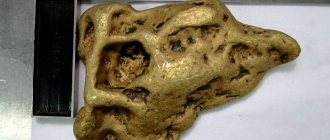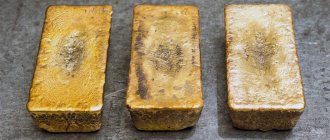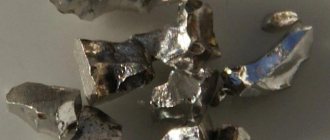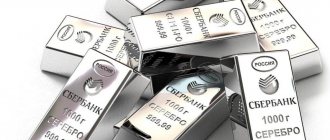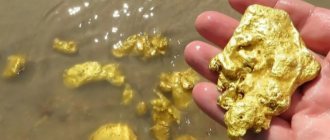What is not done in the pursuit of a rich, comfortable and carefree life. When it comes to getting rich in a relatively quick and completely legal way, the option that comes to mind for many is gold. The reserves of this one of the most precious materials, no matter how paradoxical it may sound, are not at all as great as humanity would like. This factor makes gold mining such a vital activity at all times.
The Russian Federation is one of the richest countries in the world in terms of the content of mineral resources in its depths (this especially applies to gas and oil, but also applies to precious metals). This is largely due to its long-standing stable position among the world's powerful powers. It is not surprising that mining of precious material has been carried out in such a territory for a long time, is still happening at a considerable pace and, quite likely, will continue. Where are the gold deposits in Russia? What is their role in the material well-being of a huge country and how are things going today?
Origins of the reservoir development process
Let's go back several centuries and even millennia to figure out how this process originated and where, in relation to the current Russian borders, the metal made famous by the touch of the legendary King Midas was developed.
What do the chronicles say?
The original handwritten monuments, which mention a similar phenomenon in the territory that today covers most of the continent, appeared in ancient times. In the 5th century BC, Herodotus wrote about gold mining. A historian from Ancient Greece referred to information from various travelers about the so-called “Chud mines.” These were ancient ore deposits, traces of which were found in the territory of the former Soviet Union. Gold mining in these areas began in the first half of the 3rd millennium BC. The development of ancient deposits went on for a long time and stopped in the 5th or 6th centuries in Western Siberia, much later in the Middle and Northern Urals - in the 11th or 12th centuries. Researchers involved in archeology in the north of the Caucasus managed to find burial places there of noble people with gold jewelry dating back to the third millennium BC. In addition, a hypothesis emerged that stated that Chinese gold exported to Europe during the Renaissance along the Great Silk Road originated precisely in the Amur region and Siberia.
There is no factual information about the use of gold deposits in industry in Rus' before the 17th century, despite the great popularity of this type of activity. Under Ivan III, gold coins were not of local origin at all - they were minted from imported material. The problem was finding deposits: neither Russian specialists nor foreign geological prospectors were able to find the treasured source of the precious metal and thereby meet the Tsar’s expectations.
Transition to industrial volumes
Everything changed for the better under Peter I, who established the Order (Ministry) of Mining Affairs in 1700. This led to the fact that after almost two decades, free gold mining became legal in every region of the country. Two years later - in 1721 - a proud mark began to be minted on precious metal coins, indicating that the material that served as the basis for production was mined in their homeland. However, at that time it was not yet possible to develop the treasured metal industrially.
Where was gold mined in Russia at that time?
- In 1726, the Ural entrepreneur Akinfiy Demidov attempted to organize the process of gold mining in Altai.
- Subsequently, 11 years later, Taras Antonov discovered the Voitskoye copper deposit in Karelia, where the first gold was discovered in 1783.
Industrial mining of the precious metal in the country began in 1745, when Erofey Markov, an ordinary farmer, accidentally discovered gold-bearing quartz. Then the only Berezovsky gold mine in the country was equipped at that place. At the end of the 18th century, about seventy significant sites were discovered within the boundaries of the mine. At first, the mine extracted native precious metal from quartz veins. It was only in 1814 that a technological procedure for washing placer gold from river sediments was introduced. Thanks to this, this type of metal was found along the Ural ridge.
Large-scale changes occurred in the process of gold mining under Catherine II, who put an end to the free exploitation of the precious metal and at the same time granted a mining monopoly to landowners in 1782. But 18 years later, according to a decree of the Senate, the tsarina’s orders were canceled: now free gold mining became possible for any Russian subject to the payment of taxes. This led to the fact that the volume of precious metal in the country reached the highest levels on the planet.
Russia managed to maintain its status as a world leader in gold mining for three decades, starting in 1823.
What you need to know about gold
The shine of bullion attracts people's attention, so many questions arise regarding gold, the answers to which are important to know. Translated from ancient languages, the name of the metal means “bright”. It is found in varying quantities on all known continents. It is an excellent conductor of heat and electricity. It is impossible to see gold damaged by corrosion processes - it does not rust, and therefore is so highly valued among jewelers. It also does not cause allergic reactions or skin irritations, so it is available to all people. If an allergy manifests itself, this means that the person in front of him is not pure metal, but an alloy.
Despite the active development of deposits discovered by people throughout time, according to experts, almost 80% of the metal never saw the light of day, since it is located deep in the bowels of the planet. At the same time, it has been decided to reduce the volume of gold exports from Russia today.
The jewel is also actively used in medicine, as studies have shown its effectiveness in the treatment of rheumatic diseases. In Middle Eastern countries, gold dust is added to drinks, for example, to coffee in expensive hotels or restaurants, the reason is the edibility of this metal. Some Indian tribes sincerely believed that eating it gives a person the ability to fly without special devices, that is, it opens up the possibility of levitation.
Economic crises and other financial shocks affect gold the least, so investors tend to invest in this metal. The maximum price of gold was recorded at $1,000/ounce in 2008.
The largest ingot in history was produced with a total weight of 200 kg. Modern high-tech giants, according to a study conducted several years ago, have the value of their shares equal to gold.
The most coveted award for an athlete, a gold medal, in the modern world is only a gilded likeness of the previous medal, cast entirely from the most valuable metal. On average, no more than 6 grams of yellow metal are spent on coating.
In ancient times, the Incas believed that gold was a gift from the gods. At that time, gold jewelry had not only aesthetic, but also religious significance, but at the same time they had no financial power at all. The Egyptians mined gold by sifting out its sand using sheepskin. This is probably where the legend of the “Golden Fleece” originates.
Gold in ancient times was considered part of divine power. In Egypt, it was equated to the flesh of the god Ra, so only pharaohs and clergy - priests had access to the metal. Nubia was considered the leader in production in those days.
The famous story about the golden calf today does not find sufficient evidence of its truth, and therefore scientists consider it a fiction. The reason for this is the fact that gold in those days was not yet in any way connected with money and financial calculations, therefore no one would have thought of bribing the gods with a golden calf. However, the Bible mentions gold in one form or another at least 400 times. Among other things, there is an instruction from God to cover the furniture in the tabernacle with this metal. It also acts as one of the Gifts presented by the Magi.
Further growth in production
Many historians argue that the development of Californian gold deposits was facilitated by the study of the experience of Russian colleagues in the development of deposits in Siberia and the Urals. In Russia, too, there was a kind of “gold rush” - an unprecedented rush among gold miners in the Siberian region. In the 30s of the XIX century. Only 200 prospectors worked there, and two decades later there were several hundred prospecting parties, each of which had about 10 members.
By the 1860s of the 19th century in the Siberian region:
- 459 associations related to gold mining functioned;
- Thousands of people were involved in working with the mines.
From 1819 to 1861, production volumes in Siberia amounted to as much as 583 tons of gold. In the 1850s, the fever gradually began to subside: natural resources were depleted, and production definitely lacked good management. High credit risks added obstacles to gold mining. Workers began to gradually move to the east of the country. Russian gold miners mainly mined alluvial precious metal, which, in turn, slowed down the development of the industry. However, in the meantime, technologies for extracting the precious metal from various low-grade ores continued to be developed.
By 1861, steam engines were used in only three mines in Siberia. The mining methods were quite crude and primitive. Rich deposits were actively developed, while more modest deposits were simply covered with rock. The methods of gold-bearing sands were very poorly developed, which is why about a third of the precious metal was lost. More rational and intelligent methods of gold mining were introduced only in the early 1860s. At the dawn of the last century, foreign investments began to flow into Russian gold mining.
By 1914, there were more than 250 mines and 1,500 mines in Russia.
Development of the gold mining industry in Siberia
The first to create a fairly large private mining enterprise in Siberia was the merchant Mikhail Sibiryakov. Based on civilian labor, it developed successfully for many years, competing with state-owned factories. During the years of Suvorov's activity, the productivity of the Nerchinsk plant and mines increased noticeably. Under him, a number of new factories were built and put into operation, in particular Kutomarsky in 1764, Shilkinsky in 1769, etc.
The development of the mining industry in this area immediately affected the volume of output - silver smelting increased sharply in these years, reaching 600 pounds of metal per year.
During this period of development of mining in Eastern Transbaikalia, despite the fact that the search was quite intensive and over a large area, real geological research had not yet been carried out. The discovery of deposits of non-ferrous metals was carried out by mining workers under the guidance of specialists, but local residents were often also involved in this.
In the first half of the 18th century, especially until the 40s, the bulk of specialists and managers of mining operations consisted of foreigners. Only from the second half of the 18th century. Russian officers trained in mining abroad began to work in this industry. Schools organized in the Urals began to graduate mining supervision specialists who monitored mining operations at the mine. However, there were still not enough specialists.
From the middle of the 18th century. the number of deposits is increasing, and the area of their distribution is greatly expanding. More than 1000 km separated the deposits discovered in the middle of the century on the Argun River from the Nerchinsk plant. The possibility of processing the ores of these deposits at the plant due to the distance was excluded. In this regard, new factories are being built in the Argun basin: Gazimursky, Aleksandrovsky, etc. In the second half of the 18th century. They began to create search parties. To stimulate discoveries, a special reward scale is being developed. Even at the beginning of the 18th century, despite the decree of Peter I allowing all classes to search, explore and mine various metal ores, private mining of precious metals was still very limited. The only exception was the Nerchinsk plant. By decree of June 27, 1782, Catherine II declared “mountain freedom.” But it concerned only landowners. Catherine's law significantly constrained private initiative; it not only did not contribute to the development of non-ferrous metallurgy enterprises, but, on the contrary, served to curtail them. Moreover, the proclamation of "freedom of the mountains" made it possible for many merchants and manufacturers to hide deposits of precious metals discovered on their lands. The decree also had a negative impact on the activities of the Nerchinsk plant. By 1782, silver mining by private entrepreneurs had decreased from 300 poods to 5 poods, and then stopped altogether. The overall productivity of the plant was halved.
Simultaneously with the launch of the Nerchinsk plant in Siberia, more precisely in Altai, a second mining center for the extraction of precious metals is being formed. Back in 1726, i.e., shortly after the death of Peter, Rudny Altai was transferred to Demidov to organize here according to the Ural method of mining and processing iron and copper ores. The results of Demidov’s mining activities in Altai cannot be established. However, there is reason to believe that it was here that the mining and smelting of not only copper and silver-lead ores, but also gold, began.
This, apparently, was the reason for the royal decree, according to which the entire territory of Altai in 1744 was removed from Demidov’s jurisdiction and transferred to the Cabinet, i.e., became the property of the imperial family.
By this time, a number of deposits of silver-lead ores had been discovered in Altai, characterized by a higher quality and quantity of ore in them compared to Transbaikalia (in particular, Zmeinogorskoye, Koramyshevskoye and other deposits), where ores were mined. The Kolyvano-Voskresensky silver smelting plant, built on the Loktevka River, received high-quality raw materials from these deposits. Native gold was already discovered in the ores of Altai.
From 1745 to 1800, Altai factories produced 7,741 pounds of pure silver and 223 pounds of 24 pounds of pure gold, which significantly exceeded the amount of the same metals smelted in Transbaikalia.
The search for deposits was carried out by local residents, free miners and special parties. Since the deposits had greater power and were mined for a longer period of time, here, unlike other areas, mechanization of work was more widely used using simple machines for ventilation, drainage and lifting ore to the surface.
It should be noted that in both mining regions of Siberia throughout the 18th century, gold was obtained not as a base metal, but as a by-product with the smelting of silver, and in Transbaikalia an insignificant amount was obtained. This, of course, in no way solved the problem of creating our own gold mining industry. The need for gold remained great. Therefore, the tsarist government made every effort to expand the search for gold deposits and increase its production.
Berezovskoye gold deposit 1747
The first deposit of ore gold in the Urals was discovered in 1745 by Erofey Markov, a peasant from the village of Shartash. This is the famous Berezovskoye field. In 1747, the first gold mines began operating here. By 1800, 53 pounds of 26 pounds of pure gold and 2 pounds of 32 pounds of pure silver were mined from them. However, the discovery of this deposit did not significantly change the difficult situation of the Russian gold mining industry.
It should be noted that by the end of the 18th century. The search for deposits of various metals is no longer carried out only by individual ore miners, local free scouts and hunters, as was the case in previous years. In the Urals and Siberia, numerous search parties are formed, headed by experienced mining officers, and the searches acquire a geologically meaningful character. Special geological research is beginning to be carried out. Specialist geologists visit Russia as consultants: Murchison, Pallas and others.
During these years, mining specialists already had the necessary instructions and teaching aids. Among them, the works of M. V. Lomonosov were of particular importance: “On the Layers of the Earth” and “The First Foundations of Metallurgy or Mining,” which literally became reference books for those involved in mining activities.
Development of the fishery at the beginning of the twentieth century
During the Civil War there was a big decline in gold mining. For example, in the early 1920s, gold miners managed to mine only a ton of sparkling metal. By the early 30s, private fishing had sunk into oblivion. This happened, naturally, on a voluntary-compulsory basis. They tried to replace free miners by creating artels. The workers, therefore, began to mine several times less gold. Since the country did not have funds to mechanize the process, people continued to mainly work manually in this industry.
At the dawn of the 1930s, machine-building plants, laboratories and various geological exploration organizations began to operate in the Glavzoloto system. The growth of the sphere has stalled due to long-term measures aimed at the gradual and merciless destruction of “enemies of the people”, small development of production and irrational use of existing equipment. Plans for the formation of amalgamation factories and enterprises constructing hydraulic machines turned out to be unfulfilled.
Subsequently, the sphere was transferred to completely mechanized production and the development of only state-owned industries, and benefits for artels were also abolished. Alas, the result of such reforms did not justify itself: the number of miners decreased by almost half, and production volumes were no longer so large. This is the reason why the miners had to return their benefits. In the 1930s, the average annual production was 130 tons. By 1941 it had grown to 174 tons; a larger quantity had simply become an unattainable dream.
During the Great Patriotic War, gold was consumed much faster than its reserves were replenished, which is why production had to be accelerated at a tremendous pace.
Nerchinsk Silver Smelting Plant
The first more or less reliable data on the existence of gold and silver ores in Eastern Transbaikalia was received back in 1677 from the Tungus by the head of the Nerchinsk fort, Shulgin. He reported this to the Tobolsk governor Sheremetyev. And in 1679, a royal decree was issued on the immediate start of mining work. However, it was not possible to start mining silver-lead ores and smelting them at this time. Only at the beginning of the 18th century. By decree of Peter, mining operations were resumed in this distant region. In 1704, the first Nerchinsk silver smelting plant in Siberia came into operation, where, along with silver and lead, a small amount of gold was smelted.
Nerchinsk silver smelting plant 1704
For almost 100 years of the existence of the Nerchinsk plant (from 1704 to 1800), 3,752 pounds of pure silver and 16 pounds of 17 pounds of gold were produced here. For more than 50 years, this plant was the only enterprise in the entire Eastern Transbaikalia. Until 1747, metal smelting was relatively small. The main obstacle to increasing the volume of his production was the shortage of ore. Often, the mines that supplied the plant with silver-lead ore had to be closed due to the development of ore bodies and new deposits with richer or more accessible ore for mining had to be found. Metal smelting and ore production fluctuated from year to year. In 1730, lead produced at the Nerchinsk plant in the amount of 1000 pounds was first delivered to Moscow. It turned out that its production, including delivery, is more expensive than that imported from abroad. This fact, of course, could not but affect the intensity of the work of the Nerchinsk plant. The attitude of the highest mining administration, in these years mainly consisting of foreigners, towards the activities of the Nerchinsk plant was hostile. In 1730-1734. The Nerchinsk plant almost stopped working. In subsequent years, new, more far-sighted leaders of the Russian mining industry, taking into account the large number of silver-lead deposits discovered by this time in Transbaikalia, as well as the relatively low quality of the ore in them, recommended the Nerchinsk mining administration to allow free (private) ore mining outside the plant territories . This undoubtedly was a progressive initiative in 1761-1774. carried out under the head of the Nerchinsk plant, General Suvorov.
Gold mining industry in the 50-70s
After the war, the industry was transferred to the management of Glavspetsvetmet, formed on the basis of Glavzoloto. This organization was a structure of the Ministry of Internal Affairs, which employed the labor of convicts in correctional institutions. Only in the Gulag system after the war, about 30 large structures functioned, purposefully engaged in gold mining. In 1947, the charter of artels operating in the Glavspetsvetmet system was issued. The exploitation of essentially free prison labor and certain other rational methods brought results. In 1950, production was 100 tons, and three years later, the state’s gold volumes reached an unprecedented amount - 2049 tons.
Under Khrushchev, the gold mining sector was reformed, which had a bad effect on its performance. The plans were not fulfilled, despite the discovery of new mines (in particular, in 1961 the Sukhoi Log deposit was discovered in the Lensky gold mining region). The quality of production management left much to be desired. However, in 1965, the newly formed Glavzoloto was introduced into the newly created Ministry of Non-Ferrous Metallurgy. Over the first ten years of operation, the percentage of integration of technical equipment increased; this action gained momentum after the introduction of cost accounting. Enterprises were allowed to keep a percentage of their earnings to increase production and purchase equipment.
From 1966 to 1975, the volume of production in gold mines only grew, reaching more than 280 tons.
Development of deposits at the end of the century
In the last quarter of a century, ore production began to be established in the USSR, located in Kyrgyzstan, Uzbekistan and Kazakhstan. The restructuring of the gold mining sector can be called successful. It was possible to achieve a much greater recovery of gold and reduce the cost of developing blocks through investments in the modernization of the Siberian Lenzoloto. The low rate of formation of new capacities has become the reason that the need for industrial development of small deposits has increased.
By the early 1980s, the volumes of the resulting product increased thanks to new methods brought about by perestroika. In 1990, the highest figures in history were achieved - 300 tons. However, there were also problems that hampered the development of the industry.
- Lack of balance in planning.
- The cost of work is too high.
- Only a few of the small-scale industries were transferred to a truly large-scale basis.
The decline of the economy in the late 1980s led to increased spending on gold reserves due to the USSR attracting external loans. After the collapse of the Union, gold mining volumes in Russia decreased. If the union republics produced 302 tons of product in 1990, then by 1995 this figure dropped to 132 tons. Russia had to somehow support this area, because its extinction would harm the economic situation of the country. In 1993, the Central Bank allowed Russian financial institutions to operate with gold, which, in turn, marked the beginning of the precious metals market.
In 1994, it was discovered that the budget would not help advance gold mining in the required and comprehensive volume. As a result, programs began to be formed that made it possible to move away from government financing to bank lending for production. In 1997, government price regulation was ended in order to attract production resources to the gold mining sector. Banks could export precious metals. Three years later, 76 tons of gold were used for export, and a year later - 100 tons. The export permit allowed banks to provide financial assistance to gold mining enterprises. However, such a step did not lead to significant development of the industry. Banks hardly contribute to the modernization of the technical base; labor productivity in the Russian gold mining sector remained many times lower than in other countries with high industrial development.
Gold mining in Russia: history of gold mining from antiquity to the present day
Gold mining in the territory that later became the Russian state was carried out in ancient times. However, there is no need to talk about any industrial exploitation of the deposits, due to the lack of technology and a developed economy until the 17th century. Peter I, who pushed the development of mining, created the preconditions for the development of the Ural deposits and the legendary “Siberian gold rush.”
The era of gold miners and lone miners ends after the revolution of 1917, with the emergence of a new state - the USSR - on the world map, the establishment of state-owned enterprises and the creation of artels. The development of gold mining in the Soviet era was characterized by both successes and serious mistakes, and was extremely regulated. The situation in the industry improved significantly at the stage of Gorbachev’s perestroika, but the country’s economy and the Soviet state as a whole were already on the verge of collapse by that time.
With the advent of the new Russia, new problems appeared in the industry, although since the beginning of the 2000s there has been a tendency towards an increase in production. The lack of an adequate sectoral government policy, weak indicators of investment in technology development, and a shortage of profitable deposits - all this allows only a few Russian enterprises to increase their performance.
Extraction of yellow metal in the old days
The first written mentions of the presence of large gold deposits on the territory of the future Russian state appeared in ancient times. Such records were left for posterity, in particular, by the ancient Greek historian Herodotus (5th century BC), who referred to reports from travelers. Studies of the “Chud mines” - mining blocks in Western Siberia and the Urals - led to the conclusion that metal mining was carried out in these regions back in the first half of the third millennium BC.
In Western Siberia, the development of ancient deposits stopped in the 5th or 6th centuries AD, in the Middle and Northern Urals - much later, in the 11th or 12th centuries. Archaeologists in the North Caucasus have discovered burials of representatives of the nobility with gold jewelry dating back to the third millennium BC. There is a hypothesis that Chinese gold, which was supplied to Europe in the Middle Ages along the Great Silk Road, was actually mined in the Amur region and Siberia.
Despite the rich history of extracting the precious metal in ancient times, nothing was known about industrial gold mining in Rus' until the 17th century. In particular, during the reign of Ivan III, gold coins were minted from imported metal. The Tsar, who believed that domestic ore explorers were incompetent, invited foreign geological prospectors, but they were unable to discover the deposits. The situation changed only in the era of Peter I, who established the Order of Mining Affairs in 1700. After 19 years, free gold mining was allowed in all regions of the country.
Already in 1721, an inscription was minted on gold military medals stating that the metal from which they were made was mined on the territory of the Russian state. However, by that time the industrial extraction of the precious metal had not yet been developed. Gold was a by-product that was produced during the processing of lead and copper ores. A year after the death of the tsar - in 1726 - an industrialist from the Urals, Akinfiy Demidov, tries to launch gold mining in Altai. In addition, in 1737, Taras Antonov discovered the Voitskoye copper deposit in Karelia, where the first gold was simultaneously mined in 1783.
The beginning of the gold mining era
Traditionally, 1745 is considered the beginning of the era of industrial mining of precious metals in Russia. It was then that Erofei Markov, a peasant, in the process of searching for rock crystal, which was used to create icons, discovered gold-bearing quartz in the Yekaterinburg region, on the Pyshma River. Later, the first Berezovsky gold mine in Russia was established in this area. By the end of the 18th century, about seven dozen gold-bearing areas were discovered within the boundaries of the mine.
At the first stage, labor-intensive extraction of indigenous gold from quartz veins and rocks was carried out at the deposit, and only in 1814, thanks to the initiative of foreman Lev Brusnitsyn, the technology of washing and obtaining alluvial gold from river sediments was mastered. After this, placer metal was discovered along the entire Ural ridge. However, the first statements about the rationality of the development of placer gold were made back in 1761 by Mikhail Lomonosov, and individual areas of this kind were discovered in the Ural region in 1771.
Tsarina Catherine II in 1782 about free gold mining and established a monopoly of landowners in gold mining. It is noteworthy that in 1812 the Senate issues a decree that violates the requirements of the monarch’s order - to provide all citizens with permission to mine gold, subject to the payment of taxes. Soon the country began to receive more gold than all other countries in the world. The increase in production capacity allowed Russia to become an absolute world leader by 1823 and maintain this status for 30 years.
Heyday: “Siberian fever”
Russia maintained leadership in the industry until the discovery of Californian deposits. According to historians, the development of the latter began after foreign experts studied the experience of developing the Ural and Siberian sites. Foreign researchers of those times discovered similarities in the geomorphological conditions of Siberia and the Urals with those in the snowy mountain range of California. Gold was discovered in the Californian region in 1948.
In any case, the California gold rush was preceded by a real boom in gold mining in Siberia. Back in the 30s of the 19th century, only two hundred prospectors worked there, and 20 years later - several hundred prospecting parties, each of which numbered an average of ten people. By the beginning of the 60s of the 19th century, 459 gold mining enterprises operated in the region, and 30,269 thousand people were registered at the mines. In the period from 1819 to 1861, 35,587 thousand poods (583 tons) of gold were mined in Siberia.
The decline of the “Siberian fever” began in the 1850s, which was associated with the depletion of deposits, high credit risks and the lack of competent organization of the production process. If by 1834 the density of placer mining in Western Siberia was the highest in the world, then in the second half of the 19th century the fishery moved to the east. For a long time, alluvial gold has been mined in Russia, which has left its mark on the development of the industry; in the rest of the world, technologies for extracting precious metals from low-grade ores have been intensively created.
By 1861, steam engines were used in only three Siberian mines. The methods used to develop the sites were barbaric. Only rich placers were developed; meager deposits were simply filled with rock. Imperfect methods of washing gold-bearing sands lead to the loss of a third of the metal. Only by the early 1860s did gold miners begin to introduce sustainable mining methods. However, the predatory methods of extracting the precious metal, popular in the industry, did not prevent Russia from maintaining a large share in the world market by the end of the 19th century. With the beginning of the 20th century, foreign capital began to enter Russian gold mining, which was previously an exclusively national industry. The share of foreign assets by 1914 reached 55%. By this time, there were 1,517 thousand mines and 257 mines in Russia.
Transfer of the industry to Soviet rails
The decline in private gold mining in Siberia and in Russia as a whole began during the Civil War. In the early 1920s, private owners panned only a ton of gold in Western Siberia. By the end of the decade, private fishing was completely eliminated. They tried to oust free miners by creating artels. The share of metal supplied by miners for the years 1926–1929 decreased to 2.8%, or by almost 14 percentage points. Head of state Joseph Stalin adhered to the policy of achieving maximum efficiency in gold mining exclusively by using available resources.
The country did not find the money to mechanize production, so the industry moved mainly along the path of using manual labor. And yet the industry gradually developed. With the beginning of the thirties, with the transition of gold mining to the jurisdiction of the People's Commissariat of Heavy Industry, territorial trusts, machine-building and refineries, institutes, laboratories, transport and geological exploration organizations were already operating in the Glavzoloto system.
A significant blow to the industry was the personnel purges of the late thirties as part of the campaign to destroy the enemies of the people. Fulfillment of planned indicators was put at the forefront; amateur managers simplified approaches to complex fishing. According to the People's Commissariat of Heavy Industry, the difficult situation in the industry was the result of the work of “pests.” In fact, the gold mining crisis was associated with low production technology and irrational use of available equipment. Plans for creating complete cycle production facilities, amalgamation plants, and enterprises for the production of hydraulic machines turned out to be unfulfilled by more than 20%. Losses in 1937 reached 150 million rubles, with the cost of gold being quite high.
The concept of transferring the industry to fully mechanized production emerged, and decisions were made to abolish benefits for artisanal artisans and develop exclusively state-owned fishing. The result was exactly the opposite of expectations - such a policy led to a drop in the number of miners by 40% and a reduction in production volumes. By Stalin's decision, benefits for artels were restored. In the thirties, the average annual production was 130 tons. By 1941, this figure was increased to 174 tons. During the Great Patriotic War, the consumption of gold reserves significantly exceeded its replenishment, so production had to be boosted as much as possible.
Post-war era: “Khrushchev’s thaw”, perestroika and the collapse of the USSR
In the post-war years, the industry was transferred to Glavspetsvetmet, created on the basis of Glavzoloto. The new organization was a structure of the Ministry of Internal Affairs, which primarily used the labor force of prisoners in forced labor camps. After the war, about three dozen large structures specializing in gold mining worked in the Gulag system alone.
The leadership of the Ministry of Internal Affairs managed to achieve technical re-equipment of enterprises, including the establishment of a powerful geological department. In parallel, the law enforcement department developed the mining direction - in 1947, a charter appeared for artels working in the Glavspetstsvetmet system. The use of practically free prison labor and a number of other effective measures yielded results - in 1950, 100 tons of gold were already mined, and in 1953, the country’s gold reserves reached a record level of 2,049 thousand tons. For comparison, let us recall that Pronedra wrote earlier that Russia’s gold reserves last year amounted to 1.25 thousand tons.
During the Khrushchev Thaw, the industry was reformed, which negatively affected its performance. Production management was decentralized, production was managed at the level of economic councils. Since 1957, the underfulfillment of plans has reached 10%. The situation changed in 1965, after the establishment of the Ministry of Non-Ferrous Metallurgy, which included the restored Glavzoloto.
In the first ten years of operation of the enterprise, technical equipment was increased; this process intensified after the introduction of cost accounting. From 1966 to 1975, production only grew, reaching its peak volume of 281 tons. Enterprises were allowed to keep part of their earnings for the purpose of developing production and purchasing equipment.
The establishment of ore production in the 70–80s is considered a major innovation in the USSR, although they were launched mainly in Kyrgyzstan, Tajikistan, Uzbekistan and Kazakhstan. For the most part, industry reform has been successful. For example, a significant increase in gold reclamation and reduction in the cost of block development was achieved thanks to the investment of financial resources in the reconstruction of the capacities of the East Siberian Lenzoloto. There were some delays in the construction of new production facilities - this applies to the Olimpiada mine in the Krasnoyarsk Territory and the Sukhoi Log gold mining plant in the Sverdlovsk Region. The low rate of launch of new capacities has led to the fact that the issue of industrial development of small deposits has become urgent.
In general, by the beginning of the eighties, there was an increase in production, including in connection with the renewal of approaches that perestroika brought with it. In 1990, a record gold recovery was achieved - 300 tons. At the same time, on the eve of the collapse of the USSR, which occurred in 1991, the industry retained its typical “diseases” - imbalances, high production costs, and a low level of transfer of small-scale production to a large-scale basis.
In addition, with the economic downturn in the second half of the eighties, the consumption of gold reserves increased significantly due to the attraction of external loans by the Soviet state. The controls of the gold mining industry are being transferred from the USSR Council of Ministers to the Central Committee of the Communist Party, but by this time the Union is living out its last months. A new Russian state emerges from the ruins of the USSR, and with it the next stage in the history of the industry begins.
Problems of gold mining in new Russia
After the collapse of the USSR, Russia experienced a decline in gold mining. If in the Soviet regions, which after 1991 became part of Russia, 302 tons of gold were extracted in 1990, then by 1995 the volume decreased to 132 tons. The state tried to find ways to support the industry, since its decline was detrimental to the economic interests of the country. In 1993, the Central Bank gave permission to the country's financial institutions to operate with gold, that is, in essence, the precious metals market was launched.
In 1994, during the development of the federal program for precious metals, which was led by Roskomdragmet, it became clear that it was impossible to advance production in full at the expense of the budget. After this, the Association of Russian Banks began to create a program for the transition from state financing to bank lending for production. In 1997, in order to attract production resources to the sector, state price regulation was abolished.
In the same year, banks were given the opportunity to export gold. In 2000, according to the Union of Gold Miners of Russia, 76 tons of gold were sold for export; a year later, this figure reached 100 tons. The export permit enabled banks to provide financial support to mining enterprises.
It cannot be said that such a decision gave impetus to development. To date, there has been a minimal expansion of the long-term lending system for the gold mining sector. Banks do little to improve the technical base; the level of labor productivity in the domestic industry is tens of times lower than in industrialized countries. Although there has already been a tendency to change the structure of production in qualitative terms for both ore and alluvial blocks, there are no economic and legal mechanisms for providing financial resources to promising projects.
Plans to attract foreign investment into the industry have effectively failed. The program for the production of gold and silver for the period until 2000 planned to attract financial resources for investment in the industry in the range of $1.246 billion, but in fact in 1996-1998 only $232 million out of $842 million or 27.5% were received. Only two projects with foreign investment were successfully implemented - Buryatzoloto and Omolon Gold Mining Company, related to the development of high-quality deposits.
In the period 1991–1999, gold production in the country decreased by 25.6%. The situation improved in the 2000s. A significant increase in production was observed in 2011–2014 - from 185 to 272 tons per year. The Russian Federation has taken second place in the world in terms of gold production. However, the bulk of the growth in indicators among 37 companies is currently provided by individual enterprises, the leader among which is Polyus (23% of the market). In general, the vast majority of industry operators individually are characterized by a downward trend in production.
Apart from the Sukhoi Log block in the Irkutsk region, there are simply no other areas that can provide high profitability. Let us recall that in January 2021, the competition for the development of this field was won by the joint venture of Rostec and Polyus. Yet, given the current state of affairs, a number of successful enterprises continue to experience a steady overall increase in production in Russia as a whole. Rosgeologiya, in particular, believes that by 2030 the total production volume will be 400 tons per year, with growth rates maintaining until 2050.
Current problems in gold mining include difficulties in transferring mining to the level of efficient use of resources, as well as difficulties in investing the resulting gold. Neglect of the problems of the sphere on the part of the state can lead to irreversible losses for the strategic interests of the state, since gold is a mineral with a high level of liquidity and a privileged currency commodity. To improve the situation, it is necessary, first of all, to carefully develop a national policy, the implementation of which will make it possible not only to obtain stable and efficient gold as a special component of the country’s wealth, but also to profitably operate this resource.
pronedra.ru
Two thousand years
It was not possible to obtain significant investment from abroad in the development of Russian gold. Until 2000, there was a plan to attract investment in gold mining of $1.246 billion, but in 1996-1998 the amount received was only $232 million of the planned $842 million. It was possible to implement only a couple of projects with foreign investments, both of which are related to the development of high-quality deposits.
In the first years after the collapse of the union, gold production in Russia fell by one quarter. Things started to improve in the next century. But gold mining still faces such serious problems as the difficulties of rational use of gold mining and the investment of the resulting product. Ignoring the industry’s issues by the country’s government can cause irreparable damage to the status of the Russian Federation, because metal (from which medals are made, among other things, for winners of international competitions and the Olympic Games) is a highly liquid resource, often used as currency.
A significant increase in the volume of extracted product occurred in 2011–2014: from 185 to 272 tons annually. The Russian Federation has risen to second place in the world in terms of precious metals production volumes.
How is precious metal mined?
Gold in our country is mined using various methods. Over the course of several centuries, they have been improved and still continue to change for the better. In ancient times, gold was processed by hand. People sifted through ordinary sand to mine gold. Then the technological processes of mining changed and now gold is extracted directly from the ore itself. Today, the mining process has become fully automated. But still, this is not an easy task; gold mining is considered high in terms of labor intensity.
Features of the gold-bearing areas of the country
The occurrence of strata containing the fossil, which is called the “yellow devil,” is usually located close to the earth’s surface. Geologists will be the first to name the Kuranahanskoye (in the Aldan region in Yakutia) and Khakanja (in the Far East) deposits. The precious metal is also developed from pyrite-polymetallic deposits of Rudny Altai, magmatic copper-nickel deposits that are located in the Krasnoyarsk region, and from gold-bearing skarns (deposits) in Olkhovka and Chibizhka. Important deposits where gold is mined include the Krasnoyarsk Territory, Khabarovsk, Irkutsk and Magadan regions.
Another of the main gold mining areas in the Russian Federation is the Ural Federal District. There is a suitable climate and developed infrastructure, which provides access to deposits without the slightest complications. There are two types of gold deposits known in the Urals: vein and mineralized. Some of the largest placers are: Bolsheshaldinskaya and on the Moss Swamp. The Moss Bog placer is located in the Southern Urals. This occurrence was discovered at the dawn of the 19th century and was actively used almost until the very end of the 20th century.
Industrial mining from gold deposits has essentially remained unchanged since ancient times - gold continues to be washed. Today, bulldozers, water jets, metal mesh and textured rubber mats are widely used. For small-scale mining, a mini-dredge is used (for washing sand along the shallows and spits of rivers); mini-gates (for washing and subsequent extraction of gold) and metal detectors.
The number of small but rich deposits significantly exceeds the number of those that force the use of industrial processing. Gold laundering from old dumps is certainly not without its advantages: a well-designed road network to work sites; the most ordinary requests for technical qualifications of personnel; there is no need for plowing; Relatively low-power units are used.
In the Yakutsk region, equipment that meets the latest technologies is used, which ensures the detection of the most inconspicuous gold deposits.
Introduction
On the territory of the Perm Territory, about 100 manifestations of bedrock and placer gold have been identified, mainly in the Gornozavodsky and Krasnovishersky districts.
The total reserves of placer gold of categories B+C1+C2 are about 15 tons (Krasnovishersky district - 71.3%, Gornozavodsky - 28.7%). The average gold content at the deposits varies from 200 to 300 mg/m3 per sand layer. Meanwhile, the history of gold mining in the Gornozavodsky district goes back more than 180 years, in Krasnovishersky - more than 150 years. The material composition of sand-gravel-pebble alluvial deposits of the Urals and the Urals is represented by physically stable and chemically homogeneous psephites and psammites, due to the influence of geological and hydrological factors during the mechanical integration and differentiation of sediments. The minerageny of deposits of gold-bearing alluvium from placers on gold-gravel objects is due to the mechanical integration and differentiation of sediments. Local concentrations of gold arise due to mechanical input from primary sources, intermediate reservoirs and differentiation in areas of positive neotectonic movements.
The first search for gold in the Urals began shortly after the conquest of the Perm land in 1472 and its annexation to the Russian state. In 1488, Tsar Ivan III turned to the Hungarian King Matthew Corvinus and the Austrian Emperor Frederick II with a request to send craftsmen who could search for gold and silver ores. And already in 1491, by order of Tsar Ivan III, German miners went to the north of the Urals in search of gold. The expedition was unsuccessful.
The history of gold mining in the Perm region began with the discovery of gold-bearing sands in the valley of the river in 1820 by serf prospector Prosvirin. Poludenki (territory of the Gornozavodsky district). This was facilitated by the Senate Decree of 1812 “On granting the right to all Russian subjects to discover and develop gold and silver ores,” which allowed proactive Ural plant owners to organize searches for gold deposits. Soon at the mouth of a small ravine on the left bank of the river. In Poludenki, the first mine was founded, named Adolfovsky in honor of the patron of the mining business, the French Count Adolf Antonovich Polier, master of ceremonies of the court of Alexander I.
Since 1824, gold mining in the river valley. Poludenka was carried out in separate areas of many placers.
Fragment of a page from the report
Gold-bearing rivers of Russia
The Russian Federation has many water structures in which gold can be panned.
| Reservoirs | Characteristics |
| Sanarka River. | Two centuries ago it was considered a rich deposit of minerals and precious materials. Now the area of Sanarka is partially gold-bearing. |
| Lena River basin. | One of the richest reservoirs in the Russian Federation. There is still a lot of gold left in already mined deposits, which, however, is no longer suitable for industrial mining. |
| Bodayo River. | The alluvial yellow metal of this river is mostly large: from 2 to 4 mm. In some places there are also nuggets. |
| Big Chanchik River. | There are sometimes finds weighing several kilograms. |
| River Bom. | Suitable for mining absolutely throughout its territory. It's worth looking for gold there: it may lie in the crevices between shale rocks. It often happens that the amount of material accumulated in such “caves” reaches one and a half kg. |
| Alekseevsky stream. | The gold there is large and well rolled. The nuggets weigh up to a kilogram. |
In the Jalon stream, the surface of the gold-bearing layer shone after the rains washed away the sand and thus was easy to distinguish at first glance. Palm-sized nuggets can easily be found in the Talga River even today. In the Unakha River, precious metal was collected using trays and scooped out from ferries with ladles.
Millionny Brook is famous for the fact that the placer itself was found here by accident. In 1896, a pack horse belonging to a group of smugglers fell into a ravine. When they began to pull the animal out, nuggets were found at the bottom of the stream. The placer turned out to be incredibly rich: more than 640 kg were obtained in a month.
Gold mining methods in Russia
Today, the process often takes place by obtaining the necessary product from gold ores, which is done in already known deposits. But there are other methods of extraction:
- you can use placers;
- receive secondary material after processing raw materials;
- use artisanal methods for obtaining the treasured metal (where there is relatively little of it).
Artisanal gold mining requires the installation of complex structures. The cost of such equipment is too high, so it is used only by large players in the gold mining market. The same flushing takes very little time, which is why this method is the most preferred by many in the industry.
Amalgation is a method of artisanal gold mining, which is based on the ability of mercury to form various compounds with the yellow metal. Related to this is the myth that gold leaves a black streak when it comes into contact with our skin. The essence of the secret is that a person most likely uses cream or any other cosmetic product containing mercury. The black stripe is only the result of a chemical reaction between gold and this cream. Amalgation is not a cheap method, and therefore not the most popular. There is also cyanidation, which is used by private gold miners. It is based on the following principle: hydrocyanic acid dissolves the coveted precious metal.
Development volumes before and now
Placer gold mining in the Russian Federation today amounts to more than 60 tons annually. More than half of the placers have already been mined, so the share of precious material in production is gradually falling. The bulk of the deposits are located in Siberia and the Far East. Gold production volumes are significantly higher than before. Even if we compare the figures for Siberia (583 tons in the 19th century over 50 years versus 15–20 tons per year now). This growth is explained by the development of gold mining technologies, the continuing interest in the development and enrichment of this metal, as well as the development of the country's exports.
Today, gold mining in Russia is one of the guarantees of material well-being and the state’s position in the world market. In many ways, the development of the industry is helped by rich natural resources and climate. However, at the same time, a significant part of the mines has been depleted, while the number of new deposits is not as large as we would like, which makes the prospects for gold mining in the Russian Federation far from cloudless.
Historical background on gold mining in Russia
Active gold production in Russia began to appear in the eighteenth century. There is no exact information, but it is believed that this is due to the fact that a pebble of this precious metal was allegedly found in the Yekaterinburg region by a certain schismatic. Historians claim that the person who found the first gold nugget subsequently continued to search for the same pebbles, which made it possible to find enough of them to establish a real mine. The name of the mine turned out to be quite expected: “Primary”.
The first records and mentions of the presence of gold can be found in the documents of scientific researchers. Judging by them, the first finds of gold date back to the fifth century AD. Accumulations of precious metal in the territory were observed in the Ural mountains. Evidence is provided by archaeological finds - rings and other jewelry, partly utensils and objects for economic and cultural purposes.
The gold of the Russian Empire was a special source of pride, as it served not just an economic purpose, but also a cultural one - people came from different cities and countries to look at the works of jewelers, which increased the prestige of the state in the eyes of the rulers of other states. Active development of gold deposits, and therefore the search for this metal, began after a corresponding decree issued in 1719 by Peter the Great. Less than a hundred years have passed since gold miners in Russia, among whom, first of all, were ordinary miners, brought the country to a leading position in terms of mining and processing of this sparkling metal.
Gradual development of the industry
Gold was seen not only as other minerals in Russia, but also as a source of economic stability, so the best scientific minds of their time worked to improve existing methods for extracting the metal and develop new ones. In the nineteenth century, the Urals became the basis for gold mining, and with it the western part of Siberia. During this period, the first minted coin made from gold appeared. Further reforms allowed foreign citizens to work in the mines, which caused an increase in gold exports from Russia. Today there are more than eight hundred explored and developed deposits in our country.


